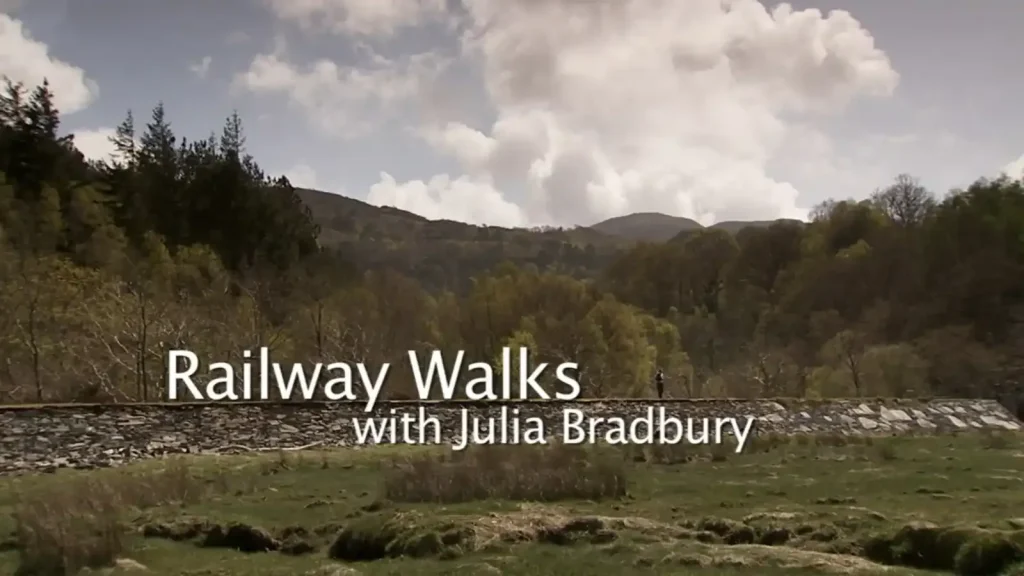Railway Walks with Julia Bradbury episode 3: In the captivating third episode of “Railway Walks with Julia Bradbury,” titled “The Birth of Steam,” viewers are transported to a time when tin and copper transformed the landscape around Redruth into one of the wealthiest regions in the country. This episode delves into the rich history and industrial heritage of Cornwall, a county that once thrived on the back of these precious metals. The prosperity brought about by tin and copper mining not only shaped the local economy but also spurred remarkable engineering achievements and the creation of pioneering tramways, which laid the groundwork for the expansive rail networks that would follow.
Julia Bradbury embarks on a journey across Cornwall, traversing an entire county that is steeped in history and marked by the remnants of its industrial past. Her adventure takes her through a picturesque yet poignant landscape, dotted with the crumbling remains of engine houses that once powered the mining industry. These relics stand as silent witnesses to a bygone era of innovation and hard labor, where steam power was harnessed to extract valuable resources from the earth.
As she follows the path of a railway that has been out of operation for over 140 years, Julia uncovers the stories of the people who lived and worked in this region during its industrial heyday. The railway lines, now overgrown and forgotten by time, were once vital arteries that transported minerals and goods across the county and beyond. They played a crucial role in the industrial revolution, facilitating the movement of raw materials to factories and finished products to markets.
Throughout her journey, Julia encounters a variety of historical landmarks and scenic vistas that paint a vivid picture of Cornwall’s industrial heritage. She explores the remains of the once-mighty engine houses, marveling at their architectural grandeur and the ingenuity of their construction. These structures, often perched precariously on the rugged Cornish landscape, were the beating heart of the mining industry, housing the massive steam engines that powered the extraction of tin and copper.
In addition to the engine houses, Julia visits other key sites that highlight the technological advancements and engineering prowess of the time. She walks along the old tramways, which were the precursors to the modern railway systems. These early transport routes were instrumental in the development of the rail empire, showcasing the innovative spirit that drove the industrial revolution forward.
Julia also takes time to appreciate the natural beauty of Cornwall, which provides a stark contrast to the industrial remnants scattered throughout the county. The lush countryside and dramatic coastline offer a serene backdrop to her journey, reminding viewers of the region’s enduring appeal. As she weaves through the landscape, Julia reflects on the delicate balance between industrial progress and environmental preservation, a theme that resonates deeply in today’s world.
One of the most poignant moments of the episode comes when Julia meets with local historians and descendants of the miners who once toiled in the depths of Cornwall’s mines. Their personal stories and anecdotes bring to life the human aspect of the region’s industrial past, adding depth and emotion to the historical narrative. Through these interactions, Julia gains a deeper understanding of the hardships and triumphs experienced by the mining communities, whose resilience and determination were instrumental in shaping the region’s history.
Railway Walks with Julia Bradbury episode 3
“Railway Walks with Julia Bradbury: The Birth of Steam” is not just a journey through Cornwall’s past; it is also a celebration of the spirit of innovation and the indomitable human will. The episode captures the essence of a time when engineering marvels and industrial advancements were at the forefront of societal progress. It highlights the transformative power of steam and the pivotal role that railways played in the development of modern Britain.
As the episode draws to a close, viewers are left with a profound appreciation for Cornwall’s rich industrial heritage and the enduring legacy of the people who contributed to its development. Julia Bradbury’s exploration of the county is both informative and inspiring, offering a unique glimpse into a chapter of history that continues to shape the present. The crumbling engine houses and disused railways serve as poignant reminders of a time when steam power revolutionized the world, leaving an indelible mark on the landscape and the people who called it home.
In summary, “Railway Walks with Julia Bradbury: The Birth of Steam” is a compelling and evocative exploration of Cornwall’s industrial past. Through her journey across the county, Julia brings to life the stories of innovation, resilience, and progress that defined an era. Her adventure is a testament to the enduring legacy of steam power and its impact on the development of railways, offering viewers a rich and engaging narrative that resonates long after the episode ends.
The Hidden Railway Legacy of Cornwall’s Mining Empire
Unveiling Britain’s Forgotten Rail Network
Imagine a silent network of embankments, platforms, and viaducts stretching across the British countryside. This isn’t a scene from a post-apocalyptic novel, but rather the reality of Britain’s disused railway lines. Among these, Cornwall’s abandoned tracks stand as a testament to a bygone era of industrial might.
For over a century, railways were the lifeblood of Britain’s development. They formed the backbone of a global superpower, connecting distant corners of the island and facilitating the movement of goods and people. However, as time marched on, many of these once-bustling routes fell into disuse. Today, an astounding 10,000 miles of disused lines crisscross the country, offering a unique window into our industrial past.
A Journey Through Time: From Coast to Coast
Cornwall, with its rugged coastline and rich mining history, offers a particularly fascinating glimpse into this forgotten world. The county’s coast-to-coast railway walk is not just a picturesque trail, but a journey through time itself. As you traverse the landscape, you’re retracing the steps of countless miners and railway workers who once made this land hum with activity.
This unique walk follows the paths of two historic railway lines: the Portreath Tramroad and the Redruth and Chasewater Railway. These routes, dating back further than many of Britain’s more famous railways, tell a story of innovation, industry, and the indomitable spirit of the Cornish people. From the dramatic cliffs of the north coast to the gentler shores of the south, this trail offers a diverse and engaging experience for history enthusiasts and nature lovers alike.
The Rich Industrial Heritage of Cornwall
To truly appreciate the significance of Cornwall’s railway legacy, we must delve into the county’s mining history. For centuries, Cornwall was at the heart of Britain’s mining industry, renowned for its deposits of tin and copper. The landscape was dotted with engine houses, their tall chimneys reaching towards the sky like industrial lighthouses.
As the mining industry boomed, so too did the need for efficient transportation. The railways became the arteries of this industrial body, pumping life-giving ore and coal to and from the mines. They transformed Cornwall from a remote peninsula into a powerhouse of the Industrial Revolution. The Portreath Tramroad, established in 1809, was one of the earliest examples of this transformation.
Yet, the story of Cornwall’s railways is not just one of industrial progress. It’s a tale of human ingenuity, of communities shaped by the ebb and flow of economic tides, and of a landscape forever altered by the quest for mineral wealth. As we explore these abandoned tracks, we’re not just walking through beautiful countryside, but through layers of history, each telling its own story of triumph and struggle.
Cornwall’s Industrial Revolution: Steam Power and Railway Innovation
Richard Trevithick: Cornwall’s Unsung Hero of Steam
In the annals of industrial history, few names shine as brightly as Richard Trevithick, yet his story remains largely untold. Born in the heart of Cornwall’s mining country, Trevithick was a visionary who saw the potential of steam power long before others. His invention of the high-pressure steam engine was nothing short of revolutionary, transforming the landscape of Cornish mining and setting the stage for global industrial change.
Imagine, if you will, the smoky, bustling atmosphere of a Cornish mine in the early 19th century. Amidst the clanging of metal and the shouts of miners, Trevithick’s engines roared to life, pumping water from ever-deeper mine shafts with unprecedented efficiency. This wasn’t just a technological leap; it was the heartbeat of Cornwall’s industrial renaissance. Trevithick’s inventions allowed miners to dig deeper, extract more, and ultimately, propel Cornwall to the forefront of the global mining industry.
The Rise of Cornwall’s First Railways
As Trevithick’s steam engines revolutionized mining, another transformation was taking place above ground. The birth of the Portreath Tramroad in 1809 marked the dawn of a new era in Cornish transportation. Picture a line of horse-drawn wagons, laden with precious ore, making their way along iron rails from the mines to the bustling port of Portreath. This simple yet ingenious system was the precursor to the railway revolution that would soon sweep across Britain.
But the story doesn’t end there. Hot on the heels of the Portreath Tramroad came the Redruth and Chasewater Railway in 1824. This more advanced line represented a significant leap forward, eventually introducing steam locomotives to replace horse power. Suddenly, the rugged Cornish landscape was crisscrossed with iron veins, pumping the lifeblood of industry – coal, ore, and other vital materials – across the county with unprecedented speed and efficiency.
Exploring the Remnants of a Mining Empire
Today, the ghosts of Cornwall’s industrial past still haunt the landscape, beckoning curious explorers to uncover their secrets. Take Wheal Peevor, for instance. This former mine site stands as a testament to the ingenuity and determination of Cornish miners and engineers. Its three iconic engine houses, silhouetted against the sky, tell a story of technological innovation and human perseverance.
Then there’s the Poldice Valley, a place where nature and industry have engaged in a centuries-long dance. Once a hive of mining activity, the valley now presents a surreal landscape. The scars of extensive mining operations are still visible, yet nature is slowly reclaiming its domain. Walking through this valley is like stepping into a living museum, where each rock and hollow whispers tales of Cornwall’s industrial might.
Preserving and Experiencing Cornwall’s Industrial Heritage
The preservation of these historic sites is not just about maintaining old buildings; it’s about keeping a crucial chapter of our industrial history alive. By exploring the Coast to Coast Trail, you’re not just taking a walk – you’re embarking on a journey through time. Every step you take follows in the footsteps of the miners, engineers, and innovators who shaped Cornwall’s destiny.
So, lace up your walking boots and set out on this extraordinary trail. As you traverse the path of old railway lines, pause to imagine the rhythmic chug of steam engines and the clatter of ore-laden wagons. Touch the weathered stones of an engine house and feel the echoes of Cornwall’s industrial heartbeat. This isn’t just a walk; it’s an immersive experience that connects you with the very essence of Cornwall’s mining legacy.
Conclusion of Railway Walks with Julia Bradbury episode 3: A Walk Through Cornwall’s Industrial Past and Present
The Legacy of Cornwall’s Mining and Railway History
As we stand at the crossroads of past and present, Cornwall’s mining and railway legacy looms large, casting long shadows across the rugged landscape. This rich industrial heritage has left an indelible mark on the county’s identity, shaping not only its physical features but also its cultural soul.
The remnants of engine houses, like silent sentinels, stand guard over a land once bustling with industrial activity. These weathered stone structures, now softened by time and moss, serve as poignant reminders of the blood, sweat, and tears that forged Cornwall’s industrial might. Yet, the impact of this era extends far beyond the visible scars on the landscape. The innovative spirit and engineering prowess born in the depths of Cornish mines have rippled outwards, influencing mining practices across the globe.
Indeed, the phrase “cousin Jack” – a term for Cornish miners who emigrated to work in mines worldwide – speaks volumes about the far-reaching influence of Cornwall’s mining expertise. From the gold fields of Australia to the copper mines of South America, Cornish miners carried with them not just picks and shovels, but a wealth of knowledge and innovation. This diaspora of skill and ingenuity has left an enduring legacy, with Cornish mining techniques and technologies shaping the development of extractive industries on every continent.
Connecting Past and Present: Cornwall’s Industrial Heritage Today
In a remarkable twist of fate, the very industry that once dominated Cornwall’s economy has now transformed into a key attraction for modern visitors. The echoes of pickaxes and steam engines have given way to the footsteps of curious tourists and history enthusiasts. Former industrial sites, once viewed as eyesores, have been reimagined and repurposed as captivating heritage attractions.
Take, for instance, the UNESCO World Heritage Site status bestowed upon the Cornwall and West Devon Mining Landscape in 2006. This recognition not only celebrates the area’s historical significance but also underscores the importance of preserving these industrial relics for future generations. Visitors can now explore once-operational mines, walk along restored railway tracks, and immerse themselves in the stories of those who toiled beneath the Cornish soil.
Moreover, this industrial heritage has sparked a new kind of innovation in Cornwall. The county is now at the forefront of geo-thermal energy exploration, harnessing the heat from its ancient granite bedrock – a modern-day echo of the resourcefulness that characterized its mining heyday. In this way, Cornwall’s industrial past is not just a static museum piece, but a living, evolving legacy that continues to shape the region’s future.
As we reflect on Cornwall’s journey from industrial powerhouse to heritage hotspot, we’re reminded of the cyclical nature of progress. The same spirit of innovation that drove the mining boom now fuels efforts to preserve and reimagine these historic sites. By engaging with this rich industrial heritage, we’re not just peering into the past, but gaining valuable insights that can inform our approach to industry, community, and environmental stewardship in the present and future.
F.A.Q. Railway Walks with Julia Bradbury episode 3
Q.: What is the main focus of “Railway Walks with Julia Bradbury: The Birth of Steam”?
A.: The main focus of this episode is to explore the rich history and industrial heritage of Cornwall, particularly how tin and copper mining transformed the region and spurred the development of early tramways, which were precursors to the modern rail network.
Q.: How did tin and copper mining impact the economy of Redruth and its surroundings?
A.: Tin and copper mining made Redruth one of the wealthiest areas in the country, significantly boosting the local economy. The prosperity from mining facilitated remarkable engineering feats and the creation of pioneering tramways that laid the groundwork for future railway systems.
Q.: What historical sites does Julia Bradbury visit in this episode?
A.: Julia Bradbury visits various historical landmarks, including the crumbling remains of engine houses and old tramways. These sites highlight the engineering prowess of the time and the significance of steam power in the industrial revolution.
Q.: What themes are explored in “The Birth of Steam” episode?
A.: The episode explores themes of industrial innovation, the balance between progress and environmental preservation, and the resilience of mining communities. It also reflects on the enduring legacy of steam power and its impact on modern railways.
Q.: How does Julia Bradbury’s journey in Cornwall enhance viewers’ understanding of the region’s history?
A.: Julia Bradbury’s journey through Cornwall provides a vivid depiction of the region’s industrial past by uncovering personal stories of miners, exploring historical sites, and highlighting the technological advancements that shaped the area. Her exploration offers a deep and engaging narrative that brings Cornwall’s history to life.




